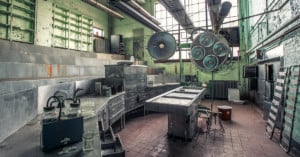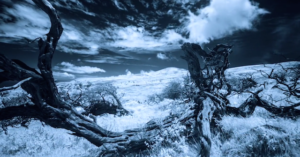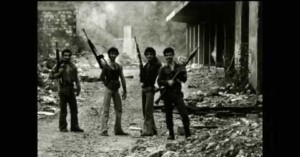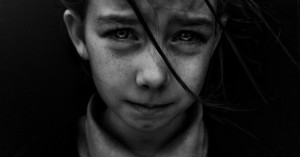
Poltergeist Photographer Recalls Case That Inspired Horror Movie
A photographer who spent months trying to capture a poltergeist in the late 1970s has talked about his experiences for a new television show.

A photographer who spent months trying to capture a poltergeist in the late 1970s has talked about his experiences for a new television show.

Filmmaker Dan Denegre of Space Race Studio recently shot a short, poignant bit of footage documenting the eerie stillness of San Francisco's once-bustling streets amid the coronavirus pandemic.

On January 13th, 2012, the giant Italian cruise ship Costa Concordia capsized and sank off Isola del Giglio, Tuscany, after running into an underwater rock, claiming 32 lives. In August 2014, in the midst of the salvaging operation, photographer Jonathan Danko Kielkowski secretly snuck onto the ship to document it in photos.

Fine art photographer Nicolas Bruno has suffered from the terrifying condition known as sleep paralysis for 10 years. Therapy for the condition ultimately led him to creative expression as a way to cope with the affliction, as he discusses with VICE’s Creators Project in this video.

Photographer and father Andy Whelan is receiving an outpouring of support from across the globe after sharing a heartbreaking photo of his 4-year-old daughter's fight against cancer.

For his book and project Abandoned Asylums, Ottawa, Canada-based photographer Matt Van der Velde took his camera into abandoned state hospitals, asylums, and psychiatric facilities across the United States.

Mahmoud Raslan’s photograph of “the boy in the ambulance” from Aleppo has struck a chord with viewers in a way that we haven’t seen since Nilüfer Demir’s image of 3-year old refugee Alan Kurdi in 2015. The photo and accompanying video of 5-year old Omran Daqneesh covered in dust and blood and sitting motionless is a stark reminder of a desperate war that started the year he was born.

When photographer Erik Hijweege realized that there were over 22,000 species on the IUCN Red List of Threatened Species, he was shocked... and inspired. Inspired to create a hauntingly beautiful series of glass ambrotypes depicting some of these endangered species encased in ice.

Eadweard Muybridge is considered one of the fathers—if not THE father—of the moving picture. But his life story is perhaps more sordid than glamorous, as this fascinating short film by filmmaker Drew Christie illustrates.

Today is Earth Day, and while many will use the opportunity to share spectacular images of natural wonders still thriving, fine art photographer Joe Freeman is taking a darker tack. His series "Clearcut" serves as a poignant reminder of nature that is no more.

It took 2 months for photographer and filmmaker Mathieu Stern to create his haunting short film "Alone in Paris." That's because it wasn't shot at odd hours when Paris' streets were empty... every scene was shot at 2pm on a weekday and then painstakingly cleaned up in Photoshop!

When the 63-story Address Downtown Dubai hotel went up in flames on New Year’s Eve, photojournalist Dennis …

While working with CBS News to capture footage for a 60 Minutes segment about the Chernobyl Exclusion Zone, filmmaker Danny Cooke got to explore the haunted landscape there in a way most people haven't yet: by drone.
The resulting video, released just 4 days ago, is called Postcards from Pripyat, Chernobyl, and it's every bit as eerie as you would imagine.

The video above by photographer Gary Yost is remarkable for two reasons. The first is that it was shot in true infrared, with a camera that had a 650 nanometer conversion applied. The second, is that the haunting, stirring quality of the time-lapse serves a greater purpose than simply offering a novel look at the Hawaiian landscape.
The subjects of the video are skeletons of the endangered Māmane trees of Hawaii. "A powerful metaphor," Yost says, "for how outsiders have crushed the native Hawaiian ecology."

Noted American photographer Arthur Tress is known for his strangely posed and articulated surrealist work. Born in November of 1940, he was merely in his twenties when one of his most poignant collections of work came to life.

Long exposure photography like UK photographer Darren Moore's is the polar opposite of the super fast, super sensitive in low light kind of photography that gets most of the attention these days. It's time-consuming and difficult, but the unearthly quality of the images that Moore produces make dealing with those challenges well worth it.

People familiar with the Brother's Grimm fairy tales know that the Disney versions of many of these tales were rather less dark than the original, broody, oh-my-goodness-did-that-just-happen-in-a-fiary-tale versions.
The photographs in German photographer Kilian Schoenberger's series Brothers Grimm's Homeland represent the latter universe: a foggy, dark, ominous place where the next footfall you hear might send you running.

There are only a few words that adequately describe photographer Perttu Saksa's series A Kind of You. Many news outlets chose "haunting" and we decided to go with "disturbing," but we could have just as easily have characterized them as "gripping."

Susan Dobson is best known for her work on suburban culture, architecture, and landscape. Her photographs have been exhibited across Canada, as well as in the United States, United Kingdom, Belgium, China, Germany, Spain, and Mexico. Her work was included in the Canadian Biennial titled Builders at the National Gallery of Canada in 2012, and she was a contributing artist to the Vancouver 2010 Cultural Olympiad. Dobson is Associate Professor at the University of Guelph.
Susan Dobson's series "Sense of an Ending" gives us look at architecture, decay and a literal sense of ending -- reminding us that eventually everything around us will become rubble. Through the use of composite imagery, Dobson crafts scenes frozen in melancholy.
As the overcast skies in each piece forebode cold and rain, and as the architectural styles have begun to weather and collapse, these images, while fiction, portray the inevitable truth of not just homes and buildings, but perhaps cities and civilizations as well.

It’s not uncommon to hear someone say that they were haunted by an image, often an old photograph. It is a figurative and evocative expression. To say that an image is haunting is to say that the image has lodged itself in the mind like a ghost might stubbornly take up residence in a house, or that it has somehow gotten a hold of the imagination and in the imagination lives on as a spectral after-image.

Here's a powerful video shared by The Economist a couple of years ago that features acclaimed British photojournalist Don McCullin talking about his 50 years of photographing war, atrocities, and human suffering. (Warning: it contains disturbing images.)

Photographer Lee Jeffries worked as a sports photographer before having a chance encounter one day with a young homeless girl on a London street. After stealthily photographing the girl huddled in her sleeping bag, Jeffries decided to approach and talk with her rather than disappear with the photograph. That day changed his perception about the homeless, and he then decided to make them the subject of his photography. Jeffries makes portraits of homeless people he meets in Europe and in the US, and makes it a point to get to know them before asking to create the portraits. His photographs are gritty, honest, and haunting.

For her project titled Marked, photographer Claire Felicie shot close-up portraits of the marines in the 13th infantry company of the Royal Netherlands Marine Corps before, during, and after their deployment from 2009-2010. She then arranged the portraits into haunting triptychs that show the toll war has on a person's eyes and face.